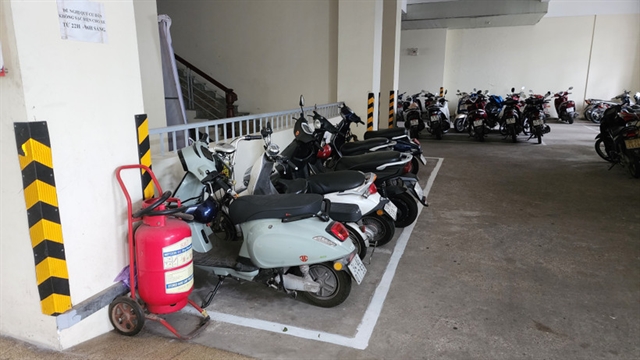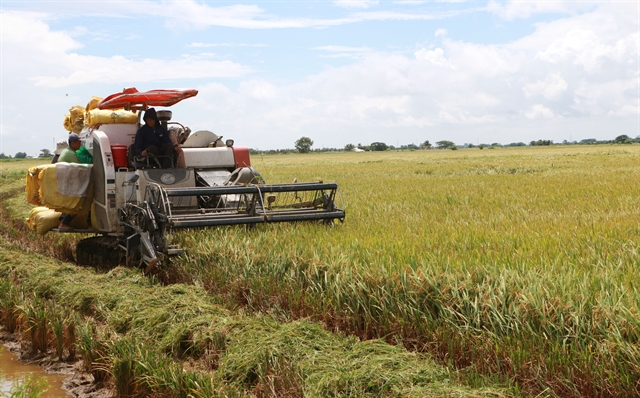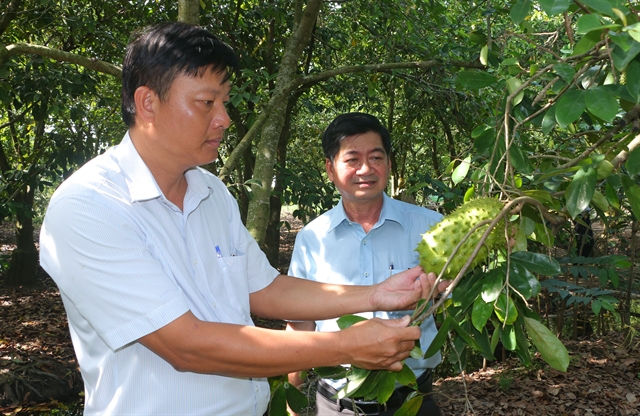 Society
Society


|
| Farmers harvest rice cultivated under the organic rice–fish farming model in Sóc Trăng Province. – VNA/VNS Photo Tuấn Phi |
SÓC TRĂNG – Sóc Trăng Province has ramped up efforts to restructure agricultural production, apply high technology, and develop effective farming models adapted to climate change.
During the 2024–25 dry season, saltwater intrusion in the Cửu Long (Mekong) Delta province was widespread, but damage was minimised thanks to the early onset of the rainy season and effective response measures.
The province has put the Rạch Mọp sluice gate in Long Phú District into operation at a cost of over VNĐ500 billion (US$19.3 million) provided by the Ministry of Agriculture and Environment.
It keeps out saltwater coming from downriver, retains freshwater and thus protects more than 36,700ha of farmland.
According to Phạm Tấn Đạo, head of the Irrigation Sub-department, the province has spent nearly VNĐ775 billion ($29.9 million) in recent years on infrastructure for agricultural development and natural disaster prevention, including repairs and upgrades of irrigation works.
He added that it has also received over VNĐ2.7 trillion ($104 million) from the Government for agricultural development and climate change adaptation projects in 2021–24.
Agriculture remains a key part of the province’s economic structure, and Sóc Trăng has focused on infrastructure investment and sectoral restructuring through the development of value chains for agricultural products.
As a result, profits from short-term crop farming have increased to VNĐ40–70 million ($1,500–2,700) per hectare per year, while fruits yield VNĐ200–400 million ($7,700–15,400).

|
| Local officials inspect a soursop orchard grown to organic standards in Ngã Năm Town in Sóc Trăng Province. – VNA/VNS Photo Tuấn Phi |
High-tech farming models such as shrimp farming, fruit cultivation for export, and integrated rice–aquaculture farming have delivered significantly higher profits compared to traditional practices.
The Hưng Lợi Agricultural Co-operative in Long Phú District’s Long Đức Commune grows ST25 rice to organic standards on 609ha, producing two crops annually.
Its yields are 6.5–7.5 tonnes per hectare per crop, generating annual profits of VNĐ4.9–5 billion ($190,000–193,000).
Trương Văn Hùng, its director, said the success of rice cultivation and partnerships with various rice companies have helped boost profits for members.
The co-operative has been recognised by the Việt Nam Farmers Association as one of the nation’s outstanding co-operatives.
In recent years, many rice farmers in coastal areas have switched to growing other crops during the dry season to cope with saltwater intrusion.
In Mỹ Xuyên District’s Thạnh Phú Commune, many have shifted to growing watermelon and vegetables between January and April, the peak saltwater season.
Lê Hồng Quang, deputy chairman of the Thạnh Phú People’s Committee, said: “The People’s Committee encourages farmers to grow two rice crops and a vegetable crop on over 50ha of rice fields. This helps secure irrigation water, reduce the impacts of climate change and limit pests and diseases.”
Sustainable farming models
Sóc Trăng has promoted the development of green and sustainable farming models to improve economic efficiency, protect the environment, maintain soil health, and enhance farmers’ livelihoods.
Its rice–shrimp and circular farming models help reduce pollution and support climate adaptation by using shrimp waste as fertiliser and green fungi for pest control.
Farmers have also adopted mechanisation and partnered with stakeholders to grow high-quality rice varieties such as ST24, ST25 and Tài Nguyên.
These varieties offer high yields, superior quality, and prices up to VNĐ3,500 per kilogramme higher than regular varieties.
Some households earn VNĐ40–50 million (US$1,500–1,900) per hectare per crop from specialty rice cultivation.
Of the more than 337,800ha of rice grown in the province last year, specialty and high-quality varieties made up 94.53 per cent, higher than the province’s target of 93.37 per cent, according to the Department of Agriculture and Environment.
Trần Vĩnh Nghi, head of the province’s Plant Cultivation and Protection Sub-department, said that projects for specialty rice production and the “Sustainable Development of One Million Hectares of High-Quality, Low-Emission Rice Associated with Green Growth in the Mekong Delta by 2030” initiative have enabled full mechanisation across all rice-growing areas.
“The province has applied advanced technologies such as drones for fertilising and spraying pesticides. In addition, the agriculture sector has introduced digital tools in production, including smart electronic light traps to monitor, predict and forecast pest outbreaks in rice fields.”
Trần Tấn Phương, deputy director of the department, said the province would continue to invest in agricultural infrastructure, apply advanced farming technologies and develop rice value chains to meet market demand.
In addition to rice cultivation, aquaculture – especially shrimp farming – is a major strength that the province is prioritising.
It is rolling out a sustainable brackish-water shrimp farming project that includes digital technology use, production restructuring through co-operative and partnership models, and the development of concentrated breeding areas.
The project aims for all shrimp farms and farming households to meet aquaculture quality standards, secure production codes for ponds breeding key aquatic species and ensure traceability for export purposes.
The province is boosting investment in infrastructure and support services such as shrimp fry production and feed supply to strengthen the shrimp value chain, create jobs, raise incomes, and foster socio-economic development.
It aims to have 57,000ha of shrimp farms this year with an output of 233,800 tonnes and export earnings in excess of $1 billion.
The province will continue to restructure agricultural production, developing new-style rural areas and responding to climate change. It will prioritise key items such as specialty rice, fisheries and fruit, while focusing on developing concentrated and high-tech shrimp farming areas. – VNS




